Download Neutron Stars Worksheets
Click the button below to get instant access to these premium worksheets for use in the classroom or at a home.
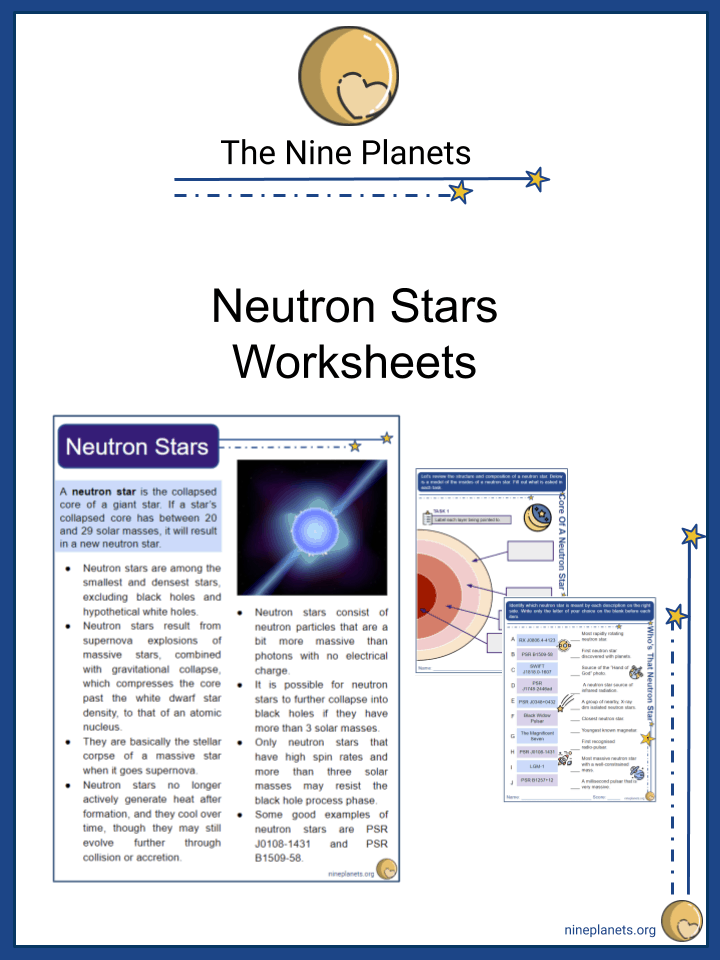
This worksheet can be edited by Premium members using the free Google Slides online software. Click the Edit button above to get started.
Download free sample
Not ready to purchase a subscription yet? Click here to download a FREE sample of this worksheet pack.
Resource Examples
Click any of the example images below to view a larger version.
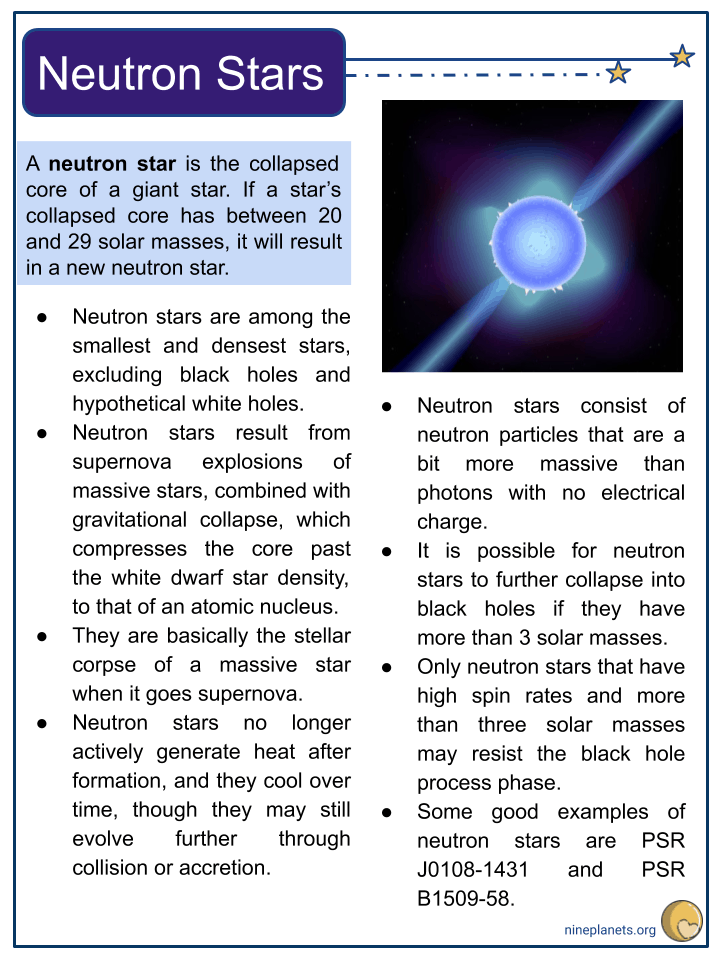
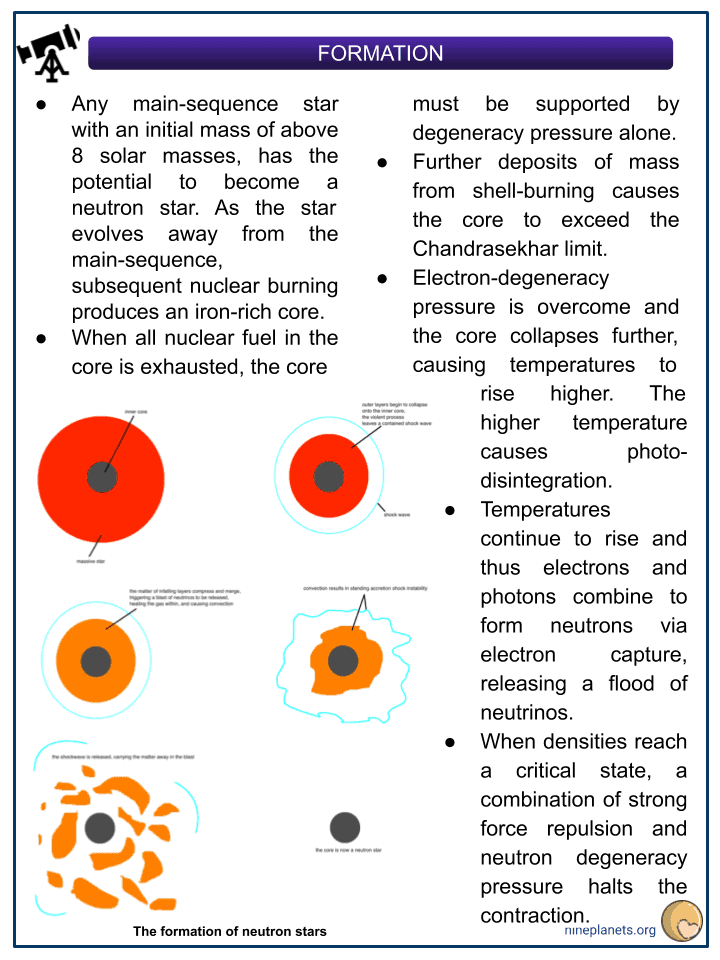
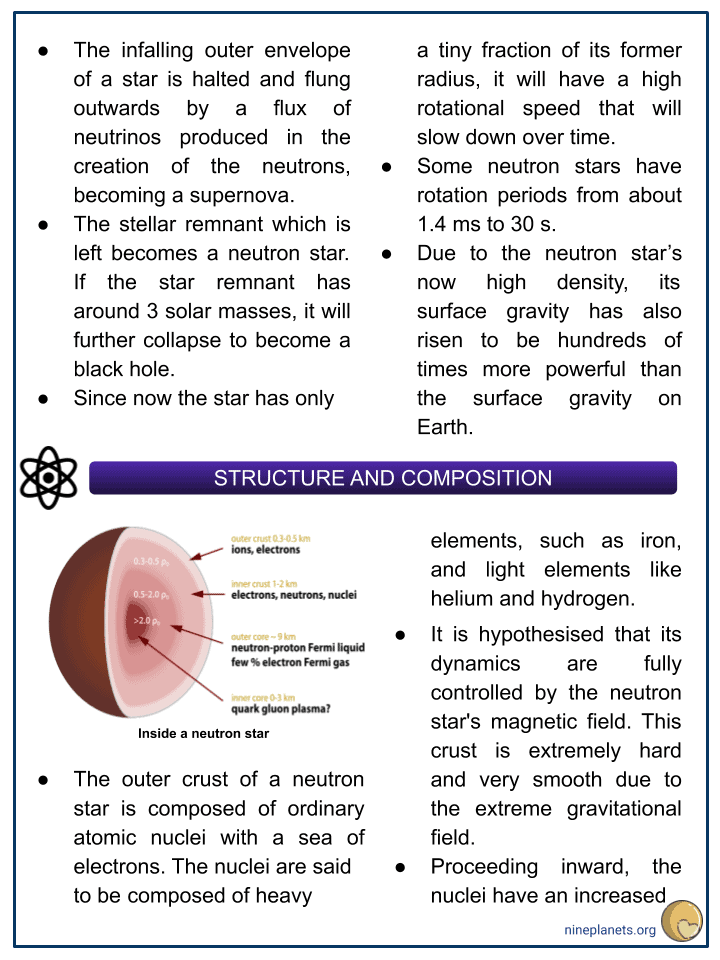
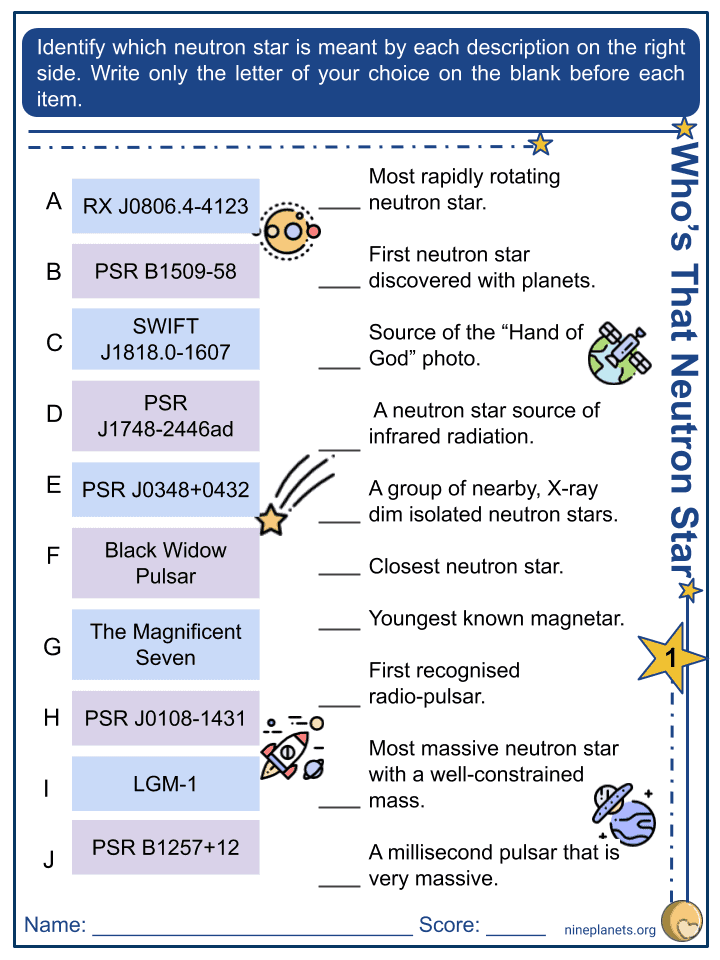
Key Facts & Information
- A neutron star is the collapsed core of a giant star. If a star’s collapsed core has between 20 and 29 solar masses, it will result in a new neutron star.
- Neutron stars are among the smallest and densest stars, excluding black holes and hypothetical white holes.
- Neutron stars result from supernova explosions of massive stars, combined with gravitational collapse, which compresses the core past the white dwarf star density, to that of an atomic nucleus.
- They are basically the stellar corpse of a massive star when it goes supernova.
- Neutron stars no longer actively generate heat after formation, and they cool over time, though they may still evolve further through collision or accretion.
- Neutron stars consist of neutron particles that are a bit more massive than photons with no electrical charge.
- It is possible for neutron stars to further collapse into black holes if they have more than 3 solar masses.
- Only neutron stars that have high spin rates and more than three solar masses may resist the black hole process phase.
- Some good examples of neutron stars are PSR J0108-1431 and PSR B1509-58.
Formation
- Any main-sequence star with an initial mass of above 8 solar masses, has the potential to become a neutron star. As the star evolves away from the main-sequence, subsequent nuclear burning produces an iron-rich core.
- When all nuclear fuel in the core is exhausted, the core must be supported by degeneracy pressure alone.
- Further deposits of mass from shell-burning causes the core to exceed the Chandrasekhar limit.
- Electron-degeneracy pressure is overcome and the core collapses further, causing temperatures to rise higher. The higher temperature causes photo- disintegration.
- Temperatures continue to rise and thus electrons and photons combine to form neutrons via electron capture, releasing a flood of neutrinos.
- When densities reach a critical state, a combination of strong force repulsion and neutron degeneracy pressure halts the contraction.
- The infalling outer envelope of a star is halted and flung outwards by a flux of neutrinos produced in the creation of the neutrons, becoming a supernova.
- The stellar remnant which is left becomes a neutron star. If the star remnant has around 3 solar masses, it will further collapse to become a black hole.
- Since now the star has only a tiny fraction of its former radius, it will have a high rotational speed that will slow down over time.
- Some neutron stars have rotation periods from about 1.4 ms to 30 s.
- Due to the neutron star’s now high density, its surface gravity has also risen to be hundreds of times more powerful than the surface gravity on Earth.
Structure And Composition
- The outer crust of a neutron star is composed of ordinary atomic nuclei with a sea of electrons. The nuclei are said to be composed of heavy elements, such as iron, and light elements like helium and hydrogen.
- It is hypothesised that its dynamics are fully controlled by the neutron star’s magnetic field. This crust is extremely hard and very smooth due to the extreme gravitational field.
- Proceeding inward, the nuclei have an increased numbers of neutrons; this nuclei would decay quickly on Earth.
- As this process continues at increasing depths, the neutron drip becomes overwhelming, and the concentration of free neutrons increases rapidly.
- The nuclei become increasingly small until the core is reached, where mostly neutrons exist. The expected hierarchy of phases of nuclear matter in the inner crust has been characterised as nuclear pasta, with fewer voids and larger structures towards higher pressures.
- The composition of the superdense matter in the core remains uncertain.
- Some model describes the core as superfluid neutron-degenerate matter including strange degenerate matter, or ultra-dense quark- degenerate matter.
Characteristics
- Neutron stars typically have a radius of 10 km / 6.2 mi and a mass of around 1.1 to 2.1 solar masses. The upper limit of mass for a neutron star is called the Tolman- Oppenheimer-Volkoff limit. This limit is generally held at 2.1 solar masses.
- A teaspoon of neutron star material would weigh 4 billion tons on Earth.
- It is believed that if a stellar remnant has more than 2.16 solar masses, it will overcome the strong force repulsion and neutron degeneracy pressure, and thus gravitational collapse will occur.
- This will produce a black hole. However, the smallest observed mass of a stellar black hole is about 5 solar masses. Most of the light generated by a neutron star is emitted in X-rays.
- These tiny stars have temperatures of around 600,000 K but they aren’t very luminous. Neutron stars have a prevalence of around 0.7% and are usually of spectral type D.
- Neutron stars are so dense that a normal-sized matchbox containing neutron-star material would weigh about 3 billion tonnes, while the gravitational field on a neutron star’s surface is 200 billion times that of Earth’s.
- They can live up to 100,000-10 billion years.
Magnetic Field
- The magnetic field strength on the surface of a neutron star ranges from around 104 to 1011 tesla. This is a powerful magnetic field that is around 100 million to 1 quadrillion times stronger than Earth’s magnetic field.
- These are orders of magnitude higher than in any other object.
Types Of Neutron Star
- There are some variations in the magnetic field of neutron stars, and they are the most likely factor which allows for different types of neutron stars to be distinguished by their spectra and which explains the periodicity of pulsars.
- The neutron stars known as magnetars have the strongest magnetic fields that photons can merge or split in two, and virtual particle-antiparticle pairs are produced. Their magnetic field is about 1,000 times stronger.
- Most of the roughly 3,000 known neutron stars are pulsars and there are now six known neutron stars that are both pulsars and magnetars.
Pulsar
- Pulsars are rotating neutron stars that display pulsation of radiation at very regular intervals that range from milliseconds to seconds.
- They have strong magnetic fields which funnel jets of particles through their two magnetic poles.
- These accelerated particles produce a very powerful beam of light. Some might say that they look like lighthouses.
- It is common for pulsars to not have their magnetic field aligned with their spin axis, thus the beams of particles and light are swept around as the star rotates. If the beam crosses our line-of-sight, we see a pulse.
- In addition to pulsars, non-pulsating neutron stars are also identified, though they have minor variations in luminosity.
- Examples are the x-ray sources known as Central Compact Objects (CCOs) in supernova remnants, which are thought to be young, radio-quiet isolated neutron stars.
- Pulsars are divided into two main categories, isolated pulsars and binary pulsars.
- Isolated pulsars produce radiation primarily through their rotation, as they gradually slow down and cool off. Their light is generated by electrons caught in the pulsar’s strong magnetic field, concentrated and emitted near the magnetic poles.
- Binary pulsars are those in orbit with a companion star, most often hydrogen- burning stars like our Sun.
- Such a pulsar can accrete matter from its stellar companion as their orbits are in close contact with each other.
- The accretion process can heat the gas being transferred and produce X-ray light. This light may pulsate at the pulsar’s rotation rate.
- Thus, binary pulsars are often called X-ray binaries
Starquake And Glitches
- Sometimes a neutron star will undergo a glitch, a sudden small increase of its rotational speed or spin up. Glitches are thought to be the effect of a starquake—as the rotation of the neutron star slows, its shape becomes more spherical.
- Due to the stiffness of the “neutron” crust, this happens as discrete events when the crust ruptures, creating a starquake similar to earthquakes.
- After the starquake, the star will have a smaller equatorial radius, and because angular momentum is conserved, its rotational speed has increased.
- Older neutron stars may take several seconds for each revolution – this is called spin down.
Location And Distance
- Currently, there are around 2,000 known neutron stars detected in the Milky Way and the Magellanic Clouds, the majority of which have been detected as radio pulsars. They are mostly concentrated along the disk of the Milky Way.
- Neutron stars are only detectable with current technology when they are in the earliest stages of their lives, often less than 1 million years.
- Some of the closest neutron stars to Earth are RX J1856.5 – 3754, situated at around 400 light years away, and PSR J0108-1431, located at around 424 light years away from us.
- These young neutron stars are vastly outnumbered by older ones that are only detectable through their blackbody radiation and gravitational effects on other stars.
Binary System
- Around 5% of all known neutron stars are members of binary systems. Neutron stars have been observed in binaries with ordinary main-sequence stars, red giants, white dwarfs, or other neutron stars. According to modern theories of binary evolution, it is expected that neutron stars also exist in binary systems with black hole companions.
- These binary systems that contain neutron stars often emit X-rays, which are emitted by hot gas as it falls towards the surface of the neutron star, the source of the gas being the companion star.
- X-ray binaries were first discovered by Dr. Riccardo Giacconi and collaborators in the early 1960s, with their binary nature established in the early 1970s by Giacconi and others.
Planets And Neutron Stars
- Though it seems counterintuitive, neutron stars can host planets. These exoplanets can be original, circumbinary, captured, or the result of the second round of planet formation.
- These planets receive little visible light yet massive amounts of ionising radiation and high-energy stellar wind. This makes them very hostile environments, and life is unlikely to develop on them.
- The first discovered exoplanets orbiting a neutron star are Draugr, Poltergeist, and Phoebetor, around the neutron PSR B1257+12. They were discovered in 1992-1994.
- Draugr is also the smallest exoplanet currently known, having twice the mass of the Moon. It is approximately 2,300 light years away from the constellation of Virgo. Another example would be the PSR B1620-26b, a circumbinary planet that orbits a neutron star-white dwarf binary system.
Examples
- Black Widow Pulsar – a millisecond pulsar that is very massive.
- LGM-1 – the first recognised radio-pulsar.
- PSR B1257+12 – the first neutron star discovered with planets
- PSR B1509−58 – source of the “Hand of God” photo shot by the Chandra X-ray Observatory.
- PSR J0108−1431 – closest neutron star.
- The Magnificent Seven, a group of nearby, X-ray dim isolated neutron stars.
- PSR J0348+0432 – the most massive neutron star with a well-constrained mass.
- RX J0806.4-4123 – neutron star source of infrared radiation.
- SWIFT J1756.9-2508 – a millisecond pulsar with a stellar-type companion with planetary range mass (below brown dwarf).
- SWIFT J1818.0-1607 – youngest known magnetar.
- The most rapidly rotating neutron star currently discovered is PSR J1748-2446ad. It rotates at around 716 revolutions per second.
The History Of Discoveries
- At the meeting of the American Physical Society in December 1933 (the proceedings were published in January 1934), Walter Baade and Fritz Zwicky proposed the existence of neutron stars, less than two years after the discovery of the neutron by James Chadwick.
- In 1965, Antony Hewish and Samuel Okoye discovered “an unusual source of high radio brightness temperature in the Crab Nebula”. This source turned out to be the Crab Pulsar that resulted from the great supernova of 1054.
- In 1967, Jocelyn Bell Burnell and Antony Hewish discovered regular radio pulses from PSR B1919+21. This pulsar was later interpreted as an isolated, rotating neutron star.
- In 1974, Joseph Taylor and Russell Hulse discovered the first binary pulsar, PSR B1913+16, which consists of two neutron stars (one seen as a pulsar) orbiting around their centre of mass.
- In 1982, Don Backer and colleagues discovered the first millisecond pulsar, PSR B1937+21.
- In 2003, Marta Burgay and colleagues discovered the first double neutron star system where both components are detectable as pulsars, PSR J0737−3039.
- In October 2018, astronomers reported that GRB 150101B, a gamma-ray burst event detected in 2015, may be directly related to the historic GW170817 and associated with the merger or collision of two neutron stars.